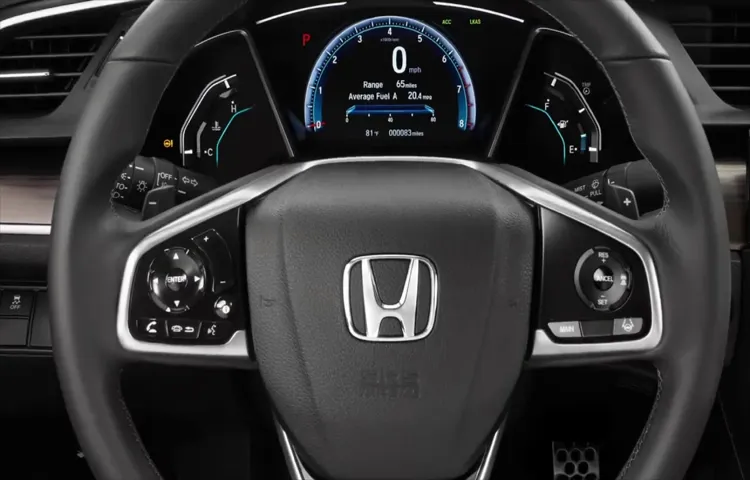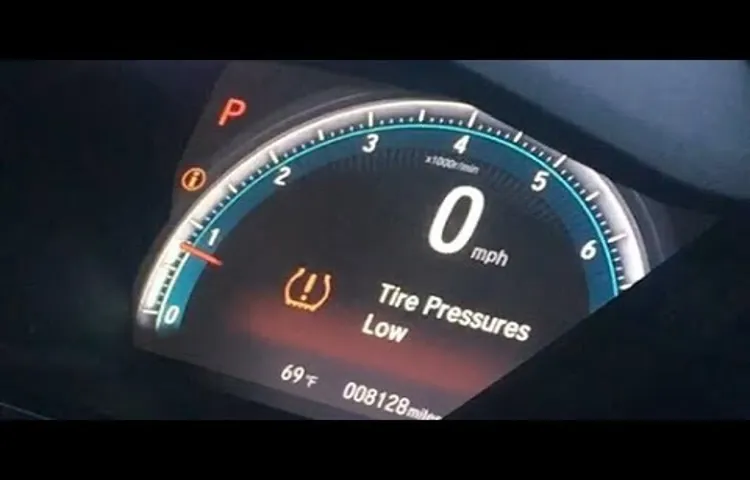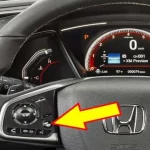Do you know the importance of checking your tire pressure in your Honda Civic? Aside from getting better gas mileage, proper tire inflation can improve your driving stability and reduce the risk of a tire blowout. It’s not just enough to depend on your vehicle’s built-in tire pressure monitoring system. You must manually inspect your tires a few times a month to ensure that they’re inflated to the manufacturer’s recommended PSI levels.
It’s a crucial aspect of vehicle maintenance that can save you both time and money in the long run. In this blog, we’ll discuss how to check your tire pressure in your Honda Civic easily and quickly. Make sure you don’t miss anything as we dive into the details.
Table of Contents
Why is Checking Tire Pressure Important?
If you own a Honda Civic, it’s important to regularly check your tire pressure. Proper tire pressure is crucial for optimal vehicle performance and safety on the road. To check your tire pressure, start by consulting your owner’s manual for the recommended tire pressure levels for your Honda Civic.
Then, use a tire pressure gauge to measure the pressure in each tire individually. If any tire is below the recommended pressure levels, you should fill them up with air until the pressure reaches the correct level. Overinflated tires can cause the vehicle to handle poorly and be more prone to accidents, while underinflated tires can lead to tire blowouts and decreased fuel efficiency.
By regularly checking your tire pressure, you can ensure a smoother ride, better fuel efficiency, and most importantly, safety on the road for you and your passengers.
Improves Fuel Efficiency
Checking tire pressure is an essential routine for every car owner, as it significantly improves fuel efficiency. When your tires have the right amount of air pressure, it reduces the friction between the tire and the road. In turn, this leads to better fuel economy because the engine doesn’t have to work unnecessarily harder to get your car moving forward.
Not only does regularly monitoring tire pressure help you save fuel money, but it also extends the lifespan of your tires. Low tire pressure often causes uneven wear and tear on your tires, meaning you might have to replace them earlier than expected. Therefore, ensuring you have the right amount of air pressure in your tires not only saves you fuel costs but also saves you the money you would have spent on new tires.
Furthermore, keeping your tire pressure in check eliminates the risk of tire blowouts, which can be dangerous and costly. Regular maintenance practices like checking your tire pressure help keep you safe, save you money, and reduce your carbon footprint.

Increases Safety
Tire pressure is a critical aspect of car maintenance that often gets overlooked. However, it’s essential to regularly check and maintain the appropriate tire pressure to guarantee driving safety. If your tires are overinflated or underinflated, it could lead to various malfunctions while driving.
For instance, if your tire pressure is too low, it decreases your car’s stability, making it more challenging to control the vehicle. On the other hand, an overinflated tire could explode, causing serious problems while driving. Checking tire pressure is a quick and easy solution to ensure your tires are safe for you and your passengers.
It’s important to note that tire pressure isn’t something you should check only when you feel like it. Instead, make a habit of checking and maintaining tire pressure once a month or before going on long trips. Regular tire pressure checks help reduce the chances of a flat tire or tire blowout, making your commute a lot more comfortable, safe, and stress-free.
What You’ll Need
If you’re wondering how to check tire pressure in your Honda Civic, don’t worry, it’s a relatively simple task. You’ll need a tire pressure gauge, which you can purchase at most auto parts stores or online. It’s also a good idea to keep a tire inflator handy in case you need to add air to your tires.
Before you begin, make sure your tires are cold, as the pressure can change when they’re hot. You’ll also want to consult your owner’s manual or the driver’s side door jamb for the recommended tire pressure for your specific make and model. Once you have your equipment and know the recommended pressure, it’s time to check your tires.
Simply remove the valve cap, press the tire pressure gauge onto the valve stem, and read the pressure measurement. If it’s below the recommended pressure, use the tire inflator to add air until it reaches the correct level. Repeat this process for all four tires, and don’t forget to replace the valve caps when you’re finished.
With proper tire pressure, you’ll enjoy better fuel efficiency, safer handling, and a longer life for your tires.
Tire Pressure Gauge
When it comes to checking the tire pressure in your vehicle, you’ll need a reliable tire pressure gauge. This tool is crucial in ensuring that your tires are properly inflated, which not only improves your vehicle’s handling and fuel efficiency but also extends the life of your tires. You can find tire pressure gauges at most auto parts stores or online retailers, and they come in two types: digital and analog.
Digital gauges are more expensive but offer precise readings, while analog gauges are more affordable and easier to use. Either way, make sure to choose a gauge that fits your vehicle’s tire pressure range and has a good reputation for accuracy. Once you have your gauge, it’s important to use it regularly and check your tire pressure at least once a month or before any long trips.
With a good tire pressure gauge in hand, you can keep your vehicle running smoothly and safely on the road.
Air Compressor
When it comes to owning an air compressor, there are a few things you’ll need to ensure you can use it properly. First and foremost, you’ll need to have an air hose. Without a hose, you won’t be able to connect your compressor to your tools.
Depending on the size and type of compressor you have, you may also need an adapter to connect your air hose. Another important component you’ll need is a pressure gauge. This allows you to accurately measure the pressure in your compressor’s tank before using it.
Some compressors come with built-in gauges, while others require you to purchase an external one. Finally, it’s important to have safety equipment on hand when using an air compressor, such as safety goggles and earplugs. These items protect you from potential hazards and allow you to comfortably operate your compressor for extended periods of time.
By ensuring you have these essential components, you’ll be able to get the most out of your air compressor while also keeping yourself safe.
Steps to Check Tire Pressure in Honda Civic
If you want to ensure proper tire maintenance and improve your vehicle’s performance, checking the tire pressure regularly is important. When it comes to a Honda Civic, you need to follow some simple steps to get the job done. The first step is to find the recommended tire pressure on either the owner’s manual or the door jamb sticker.
Then, you need to use a tire pressure gauge to measure each tire’s pressure individually. You can find the tire valve on the rim and place the gauge on it to get an accurate reading. Make sure to repeat the process for all four tires and compare the pressure reading to the recommended one.
If any tire’s pressure is low, use an air compressor to inflate it to the indicated level. Remember to regularly check the tire pressure and maintain it to keep your car running smoothly with good fuel efficiency.
Step 1: Locate Tire Pressure Information
If you own a Honda Civic and want to check your tire pressure, you’ll need to find the tire pressure information first. The easiest way to locate this information is by checking your owner’s manual, where you’ll find the recommended tire pressure for your specific model. Another way to find this information is by looking for the tire label, which is often located on the driver’s side door jamb or inside the glove compartment.
This label will provide you with specific details, including the correct tire pressure for your vehicle as well as the size and type of tires it requires. Knowing the correct tire pressure is essential for maintaining safe and efficient driving, as incorrect tire pressure can lead to decreased fuel economy and increased risk of accidents. By taking the time to locate and check the tire pressure in your Honda Civic, you can ensure you’re driving as safely and efficiently as possible.
Step 2: Prepare the Tire Pressure Gauge
After ensuring that your Honda Civic is parked on a level surface, the next step to checking tire pressure is preparing the tire pressure gauge. It is important to use a properly calibrated tire pressure gauge to ensure accurate readings. Most Honda Civics need a tire pressure of 32 psi, but it is always better to confirm the correct pressure from the car manual or the tire manufacturer’s website.
Once you have the correct pressure, unscrew the valve cap from each tire and press the gauge onto the valve stem. A hissing sound indicates that the gauge is making contact with the valve. Hold it steady for a few seconds and then remove it to check the reading.
This is a great opportunity to check for any damage or wear on the tires, such as cracks, bulges, or punctures. If the pressure is below the recommended levels, inflate the tire with a pump until you achieve the correct pressure. Using a tire pressure gauge in a Honda Civic ensures your safety and prolongs the life of your tires.
Step 3: Remove Valve Cap and Check Pressure
When it comes to maintaining your Honda Civic, checking the tire pressure regularly is an important task. Here’s how you can do it in three easy steps. First, locate the valve stem on your tire and remove the cap.
Next, take a tire pressure gauge and press it onto the valve stem firmly. You should hear a small hissing sound as the gauge takes a reading of the pressure. Be sure to take the reading when the tire is cold as air pressure increases as the tire warms up.
Finally, if the reading is lower than the recommended pressure listed in your Honda Civic’s owner’s manual, inflate the tire with a tire inflator until you hit the recommended level. Don’t overinflate the tire, as it can be dangerous and cause the tire to burst. With these steps, you can ensure that your Honda Civic’s tires are properly inflated and keep you safe on the road.
Step 4: Compare Reading to Recommended Pressure
After taking the tire pressure with a gauge and making sure it’s within the recommended range, it’s time to compare it to the recommended pressure for your Honda Civic. This information can be found on the owner’s manual, the driver’s side doorjamb, or even online. It’s crucial to check this as over-inflated or under-inflated tires can result in decreased fuel efficiency, uneven wear, and even hazardous driving conditions.
If the reading matches the recommended pressure, you’re good to go! If it doesn’t, add or release air until it reaches the proper level. Remember, regularly checking your Honda Civic’s tire pressure is an easy and essential task that can ensure your safety and prolong the lifespan of your tires.
Step 5: Add or Release Air as Necessary
Now that you’ve checked the pressure on your Honda Civic’s tires, it’s time to add or release air as needed. If the pressure is too low, you’ll want to add air using a tire inflator or air compressor. On the other hand, if the pressure is too high, you’ll need to release some air until it reaches the recommended level.
When adding air, it’s crucial to use a tire gauge to monitor the pressure and avoid overinflating, which can cause uneven wear on the tire. Remember to use the recommended pressure level listed in your Honda Civic’s owner manual or on the driver’s side door jamb sticker. Maintaining the correct tire pressure is essential for safe driving and extending the life of your tires, so don’t overlook this step.
Conclusion
In the words of the great philosopher Socrates (or was it Oprah Winfrey?), the first step to wisdom is admitting you don’t know everything. So, if you’re not sure how to check the tire pressure in your Honda Civic, fear not! It’s a simple process that anyone can learn. Just grab a tire pressure gauge, locate the recommended pressure for your tires (usually found in your owner’s manual or on a sticker inside the driver’s side door), and check each tire individually.
And remember, a little bit of knowledge can go a long way—properly inflated tires not only improve your Honda’s performance but also save you money on gas and tire replacements. So, embrace the power of learning and keep those tires inflated, my friends!”
FAQs
What is the recommended tire pressure for a Honda Civic?
The recommended tire pressure for a Honda Civic is typically 32 PSI.
Why is it important to check tire pressure in a Honda Civic regularly?
Checking tire pressure regularly ensures optimal tire performance and fuel efficiency, as well as preventing accidents from low pressure or over-inflation.
How often should I check my tire pressure on my Honda Civic?
It is recommended to check tire pressure on your Honda Civic at least once a month, or before long trips.
Can I check my tire pressure in a Honda Civic on my own?
Yes, you can check your tire pressure on a Honda Civic with a tire pressure gauge, which can be purchased at most auto stores.
Should I inflate my tires to the maximum PSI indicated on the tire sidewall?
No, you should not inflate your tires to the maximum PSI indicated on the tire sidewall. Instead, use the recommended PSI provided in your Honda Civic owner’s manual.
What are the consequences of driving on under-inflated tires in a Honda Civic?
Driving on under-inflated tires in a Honda Civic can lead to decreased fuel efficiency, decreased handling and braking performance, and premature tire wear and damage.
What should I do if I notice my Honda Civic tire pressure is low?
If you notice your Honda Civic tire pressure is low, inflate the tires to the appropriate PSI as soon as possible to avoid potential safety hazards and damage to the tires.



